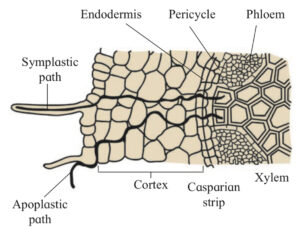
1. Root hairs, originating as tubular extensions of epiblema cells, play a crucial role in absorbing capillary water from the soil.
2. The absorption of water involves three key physical processes: imbibition, diffusion, and osmosis.
3. Imbibition occurs as water molecules are adsorbed on the cell wall of the root hair, contributing to the overall absorption mechanism.
4. The diffusion process takes place through the freely permeable cell wall, allowing water to enter the root hair cell.
5. Subsequently, osmosis becomes prominent as water permeates the semipermeable plasma membrane of the root hair cell.
6. The result of this absorption process is an increase in turgor pressure within the root hair cell, leading to a decrease in its D.ED. value.
7. In the adjacent cortex, cells exhibit a higher D.ED. value due to their elevated osmotic potential.
8. A dynamic interplay unfolds as cortical cells draw water from the turgid epidermal cells, generating a suction pressure gradient.
9. This suction pressure gradient propels the movement of water through the cells of the endodermis, pericycle, and eventually into protoxylem cells, facilitated by hydrostatic pressure.
10. The journey of water is facilitated by two pathways: apoplast and symplast.
11. Along the apoplast pathway, water traverses through cell walls and intercellular spaces within the cortex.
12. Conversely, the symplast pathway involves water passing across living cells through their interconnected plasmodesmatal connections, contributing to the intricate water absorption mechanism in plants.